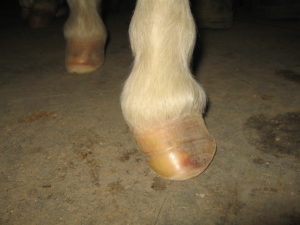Can It Be Fixed?

Although this angular deformity looks bad, this pony is not lame. Farriers shouldn’t try to correct or fix something that isn’t bothering the animal.
Sometimes farriers think of themselves as “fixers.” This isn’t necessarily a bad thing. As animal welfarists, we want to help horses. If a horse has a foot problem we immediately think about how we can attenuate the horse’s problem. If the horse doesn’t respond to treatment, farriers may feel responsible. To add to this impractical pressure, horse-owners also think of farriers as “fixers” and often have extreme, unrealistic expectations. The truth is that there are simply some problems farriers (and veterinarians) cannot fix.
Foot and limb conformations are estimated to have .65 heritability. This means that 65 percent of conformation’s cause is due to heredity or genetics and 35 percent is due to environment or management. Some people wrongly get the idea that we can “fix” these conformational defects. It is true that we can have some influence on straightening young foals’ deviated feet or limbs by applying glue-on extensions. However, the best time to positively affect conformation is when the stallion is introduced to the mare. Conformation is passed on through breeding. Though we may accommodate horses with these problems with good trimming or shoes that can make them more comfortable, it is a fallacy to say that we can fix it.
Horses have to be assessed individually. What works for one horse may not work for another. The question to ask is: “What does this horse need?” Recently, a horse was brought to the school with a very crooked foot. The deformity looked as though it would limit the horse’s locomotion, but the horse seemed to have no problem getting around. Even at speed the horse was not lame. The opposite front foot did not show any signs of compensatory lameness or of bearing more weight than the other deviated limb. It looked bad. But the horse was not affected. Therefore, the horse’s crooked foot should be trimmed with the same medial/lateral balance it had before the trim.
When the “fixing” mentality kicks in, some farriers want to make the foot look straighter by trimming more off of the side that is not weight-bearing. In the last 25 years, some clinicians have advocated trimming all horses so that the coronary band is parallel to the ground from the X-view. But not all horses are the same. An angular deformity can be made worse by following these misleading guidelines. There is nothing wrong with an asymmetrical coronary band if the horse is not lame. The price of cosmetically fixing a crooked foot may be a crippled horse.
If a crooked-legged horse is not lame but the shoe is worn on one side, a shoe that extends medially or laterally may be helpful to evenly distribute weight. The goal is uniform shoe wear. This accommodates the horse’s conformation but doesn’t fix it. Many crooked-legged horses have had successful careers because a competent farrier accommodated the horse’s conformation.
It’s important to remember that we can’t fix everything. Assessing each horse individually and developing a plan to help is what makes this job rewarding and fun. Just because a foot is crooked, doesn’t necessarily mean that the horse will be lame. There is some wisdom in the adage, “If it isn’t broken, don’t fix it!”
Related Posts
-
With the holidays approaching, we are offering a discount on...Nov 30, 2017 / 0 comments
-
It is very difficult, if not impossible, for farriers to det...Jan 18, 2018 / 0 comments
-
Horsemanship is such a vital part of being a skilled farrier...Dec 12, 2019 / 0 comments
Blog Categories
- Anatomy
- Best Business Practices
- Conformation
- Current Events
- Customer Service
- Draft Horse Shoeing
- Equine Soundness
- Essential Anatomy Kit
- Farrier Careers
- Farrier training
- Foal soundness
- Horse Care
- Horse Foot Care
- Horse Owner Tips
- Horsemanship
- Horseshoeing
- Horseshoeing History
- Iron and Forge Work
- Student Spotlight
- Uncategorized
- Veterinary Care
Blog Archives
Contact Us
Butler Professional Horseshoeing School
495 Table Road
Crawford, NE 69339
(800) 728-3826
jacob@dougbutler.com
Subscribe to Our Blog
Get Our Free e-Book!
If you think you want to become a farrier (or know someone who does), this book can help you make that decision. Horse owners will learn the importance of choosing a qualified farrier and how to select the “right” one.
[ Get the e-Book Now! ]
- Follow:
